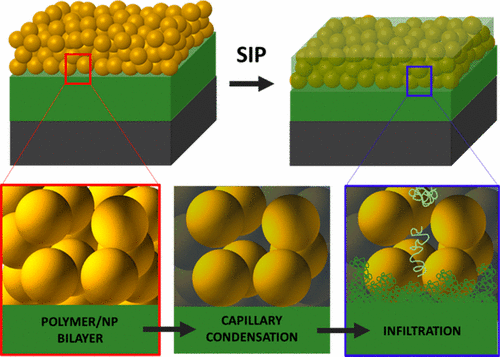当前位置:
X-MOL 学术
›
ACS Macro Lett.
›
论文详情
Our official English website, www.x-mol.net, welcomes your feedback! (Note: you will need to create a separate account there.)
Solvent-Driven Infiltration of Polymer (SIP) into Nanoparticle Packings
ACS Macro Letters ( IF 5.8 ) Pub Date : 2017-09-20 00:00:00 , DOI: 10.1021/acsmacrolett.7b00392 Neha Manohar 1 , Kathleen J Stebe 1 , Daeyeon Lee 1
ACS Macro Letters ( IF 5.8 ) Pub Date : 2017-09-20 00:00:00 , DOI: 10.1021/acsmacrolett.7b00392 Neha Manohar 1 , Kathleen J Stebe 1 , Daeyeon Lee 1
Affiliation

|
Despite their wide potential utility, the manufacture of polymer–nanoparticle (NP) composites with high filler fractions presents significant challenges because of difficulties associated with dispersing and mixing high volume fractions of NPs in polymer matrices. Polymer-infiltrated nanoparticle films (PINFs) circumvent these issues, allowing fabrication of functional composites with extremely high filler fractions (>50 vol %). In this work, we present a one-step, room-temperature method for porous PINF fabrication through solvent-driven infiltration of polymer (SIP) into NP packings from a bilayer film composed of a densely packed layer of NPs atop a polymer film. Upon exposure to solvent vapor, capillary condensation occurs in the NP packing, leading to plasticization of the polymer layer and subsequent infiltration of polymer into the NP layer. This process results in a porous PINF without the need for energy-intensive processes. We show that the extent of polymer infiltration depends on the quality of solvent and the duration of solvent annealing as well as the molecular weight of the polymer. SIP can also be induced using a slightly poor solvent, which offers a great advantage of inducing SIP via liquid solvent annealing, eliminating potential hazards associated with solvent vapor annealing. The SIP process circumvents challenges associated with dispersing high concentrations of nanoparticles in a polymer matrix to prepare a nanocomposite film with high filler fraction. Thus, SIP is a potentially scalable method that can be used for the manufacturing of porous PINFs of a wide range of compositions, structures, and functionalities for applications in structural and barrier coatings as well as electrodes for energy storage and conversion devices.
中文翻译:

溶剂驱动的聚合物 (SIP) 渗透到纳米颗粒填料中
尽管具有广泛的潜在用途,但由于难以在聚合物基质中分散和混合高体积分数的 NP,因此具有高填料分数的聚合物-纳米颗粒 (NP) 复合材料的制造面临重大挑战。聚合物渗透的纳米颗粒薄膜 (PINF) 规避了这些问题,允许制造具有极高填料分数 (>50 vol%) 的功能性复合材料。在这项工作中,我们提出了一种一步、室温的多孔 PINF 制造方法,该方法通过溶剂驱动的聚合物 (SIP) 渗透到 NP 填料中,该方法是由聚合物薄膜顶部的密集堆积的 NP 层组成的双层薄膜。暴露于溶剂蒸气后,NP 填料会发生毛细管冷凝,导致聚合物层的塑化和随后聚合物渗透到NP层中。该过程产生多孔 PINF,而不需要能量密集型过程。我们表明聚合物渗透的程度取决于溶剂的质量和溶剂退火的持续时间以及聚合物的分子量。SIP 也可以使用稍差的溶剂来诱导,这提供了通过液体溶剂退火诱导 SIP 的巨大优势,消除了与溶剂蒸汽退火相关的潜在危险。SIP 工艺规避了与将高浓度纳米粒子分散在聚合物基质中以制备具有高填料分数的纳米复合膜相关的挑战。因此,
更新日期:2017-09-20
中文翻译:

溶剂驱动的聚合物 (SIP) 渗透到纳米颗粒填料中
尽管具有广泛的潜在用途,但由于难以在聚合物基质中分散和混合高体积分数的 NP,因此具有高填料分数的聚合物-纳米颗粒 (NP) 复合材料的制造面临重大挑战。聚合物渗透的纳米颗粒薄膜 (PINF) 规避了这些问题,允许制造具有极高填料分数 (>50 vol%) 的功能性复合材料。在这项工作中,我们提出了一种一步、室温的多孔 PINF 制造方法,该方法通过溶剂驱动的聚合物 (SIP) 渗透到 NP 填料中,该方法是由聚合物薄膜顶部的密集堆积的 NP 层组成的双层薄膜。暴露于溶剂蒸气后,NP 填料会发生毛细管冷凝,导致聚合物层的塑化和随后聚合物渗透到NP层中。该过程产生多孔 PINF,而不需要能量密集型过程。我们表明聚合物渗透的程度取决于溶剂的质量和溶剂退火的持续时间以及聚合物的分子量。SIP 也可以使用稍差的溶剂来诱导,这提供了通过液体溶剂退火诱导 SIP 的巨大优势,消除了与溶剂蒸汽退火相关的潜在危险。SIP 工艺规避了与将高浓度纳米粒子分散在聚合物基质中以制备具有高填料分数的纳米复合膜相关的挑战。因此,


























 京公网安备 11010802027423号
京公网安备 11010802027423号